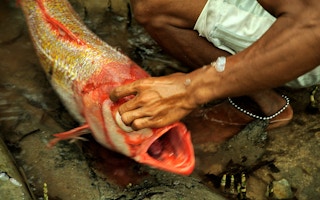Many of the fishing vessels operating in Indonesia’s waters at night do so undetected, masking what could be illegal fishing on a massive scale, according to a new study.
Nearly 94 per cent of nocturnal lit marine activities in Indonesia don’t use the vessel monitoring system (VMS), which tracks the location and activities of commercial fishing boats, said the researchers behind the study published April 26 in the journal Remote Sensing.
Some of this can be attributed to vessels smaller than 30 gross tonnage (GT), which aren’t required under the Indonesian law to use VMS. But the authors highlighted what they called “dark vessels,” where boats larger than 30 GT, both Indonesian-flagged and foreign, switched off their tracking devices, likely to avoid detection. In Indonesia, VMS is required on boats over 30 GT, which account for 10 per cent of the domestic fishing fleet.
The researchers analysed 2.1 million records of boat detection using low-light imaging data collected by the NASA/NOAA Visible Infrared Imaging Radiometer Suite (VIIRS), and cross-matched them with VMS records of 3,600 vessels in Indonesia spanning 32 months between 2014 and 2016, provided by Global Fishing Watch.
In 2017, the Indonesian government began to publish the country’s private VMS data on GFW’s mapping platform as part of an effort to improve surveillance in one of the world’s largest fisheries.
“The VIIRS boat detection data and VMS tracks are the only available nationwide data recording night time fishing activity,” Chris Elvidge, a co-author of the recent study and member of NOAA’s Earth Observation Group, wrote in an email to Mongabay.
The researchers suggested that if the matching of two data sets in near real time became available, it would greatly help the authorities identify these dark vessels that didn’t broadcast their location.
“In some areas, this is a tip-off for potentially illegal fishing,” the paper said, noting reported incidents where vessels turned off their tracking system while engaged in illegal fishing.
The researchers also suggested that cross-matching the data sets could be applied to identify events of transshipment, in which fish catches are transferred between boats out at sea instead of at port. The practice is widely criticised as it allows for overfishing, undocumented fishing, and an excessive workload for the boat crews.
“We are currently providing daily alerts to stakeholders [in Indonesia] when detections [of illegal fishing] are found within designated waters,” said study lead author Feng-Chi Hsu, a researcher with the NOAA-funded Cooperative Institute for Research in the Environmental Sciences, in the email to Mongabay.
The researchers said further studies building on these findings could be used to estimate unreported catches and improve stock assessments as well as provide other information relevant for decision-makers.
In Indonesia, the fisheries ministry has only partially employed the application of cross-matching VIIRS boat detection and VMS data to monitor fishing activities, according to Yeppi Sudarja, a division head at the ministry’s fleet operation and monitoring directorate, who was also involved in the study.
“
We are currently providing daily alerts to stakeholders [in Indonesia] when detections [of illegal fishing] are found within designated waters.
Feng-Chi Hsu, researcher, Cooperative Institute for Research in the Environmental Sciences
Yeppi said the VIIRS boat detection still couldn’t cover all types of fisheries and all fishing grounds in the archipelago.
“The VIIRS detection system is still being developed to gain better results,” he told Mongabay. “As long as the results don’t match the [government’s] needs, then the application of the system is limited to certain events only.”
At present, VIIRS provides the only national-level daily fisheries monitoring of vessels under the 30 GT threshold for VMS usage. Yeppi said VIIRS boat detection was effective in monitoring activities within marine conservation zones in Indonesia.
Elvidge said there were fishing grounds where VIIRS boat detection revealed many boats, none of them using VMS. He called on stakeholders outside the Indonesian fisheries ministry to employ the two publicly accessible data sources to contribute to improving surveillance of nighttime fishing activity in the country.
“Without monitoring systems there can be no improvement in fishery surveillance,” he said.
This story was published with permission from Mongabay.com.










